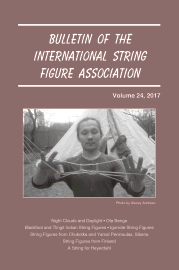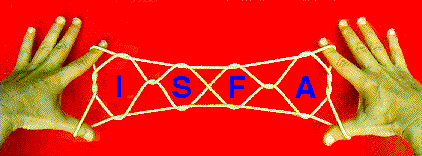Volume 24 (2017): 215 pages - Table des Matières
Edité par - Mark A. Sherman, Pasadena, California
Rédacteurs Associés - Joseph D'Antoni, Queens, New York; Myriam Namolaru, Haifa, Israel;
Belinda Holbrook, Davenport, Iowa; Stephan Claassen, Best, Netherlands.
Comité de Rédaction - Hiroshi Noguchi, Tokyo, Japan; Philip Noble, Inverness, Ecosse
Le Bulletin de l'Association Internationale du Jeu de Ficelle (BISFA) est une publication savante
présentant des documents originaux qui fait progresser notre compréhension et renforce
notre plaisir des jeux de ficelle. BISFA est publié annuellement, en septembre, par ISFA Press
(Pasadena, Californie). BISFA remplace le Bulletin de l'Association des Jeux de Ficelle,
(Toky Nippon Ayatori Kyokai), qui a été publiée en 19 volumes (1978-1993).
Les traductions proposées ne comprennent pas les illustrations et photos du texte original.
J'ai traduit ces textes pour vous donner un aperçu de la qualité et de la richesse de
ces publications.

Research Reports
- Night Clouds and Daylight by Martin Probert, Devonshire, UK (pages 1-7) - Presenting a simplified set of instructions for the collected method, and a simplified alternative method, for the British Guiana (Guyana) figure Night clouds and daylight.
- OTA BENGA: L'homme derrière les diamants Pygmés par Philip D. Noble, Inverness, Scotland (pages 8-15) - En 1904, à l'Exposition St. Louis, Caroline Furness Jayne a recueilli un des premier jeux de ficelle africain décrit. Son informateur était un Pygmée de la Vallée Kasai , Congo, dont le nom était "Ottobang" (Ota Benga). Dans cet article l'auteur passe en revue la vie et le destin tragique de l'informateur pygmée de Jayne. L' article conclut par un appendix qui examine comment les recueilleurs de jeux de ficelle peuvent sans le savoir biaiser le répertoire de motifs qui a été réalisé par leurs informateurs.
- The Haddon Family's 1909 String Figure Collection: An introduction by Mark Sherman, Pasadena, California (pages 16-22) - In the summer of 1909 Dr. Alfred C. Haddon, his wife Fanny, and his two daughters Mary and Kathleen traveled from Great Britain to the United States to attend the Alaska-Yukon-Pacific Exposition in Seattle, Washington. While there they collected twelve string figures from Siberian Chukchi informants and two from Filipino Igorrote informants. Later, while working in Montana with Edward S. Curtis, Dr. Haddon was able to collect ten string figures and three tricks from Blackfoot Indian informants. Meanwhile daughters Mary and Kathleen visited the Alaskan panhandle and collected two string figures from Tlingit informants. Surprisingly, only a few of the figures gathered in 1909 were subsequently published. In this introduction to the collection, the author reviews the context and history of the Haddon family's excursion to the Pacific Northwest.
- A 1909 Collection of String Figures from Chukotka Peninsula: From the Haddon string figure manuscripts at Cambridge, File 5141 by Stephan Claassen, Best, Netherlands (pages 23-92) - This paper presents twelve different string figures or short sequences of figures that were collected in 1909 at the Alaska-Yukon-Pacific Exposition by Ethel and Kathleen Haddon. The informant for all figures was Nahout (or Bahout), a man from Chukotka Peninsula, Northeastern Siberia. Although there is no decisive proof, Nahout appears to be of Chukchi origin. The collection of figures belongs to the Alaskan and Northeastern Siberian string figure tradition. One of the figures has (as far as is known) not been recorded elsewhere, but it is a variant of a figure that occurs regularly in the Arctic region. One short series of figures was probably recorded before at the westernmost tip of Alaska. The limited information available suggests that Nahout chose a particular construction technique based on particular characteristics of the string configuration.
- A 1909 Collection of Blackfoot Indian String Figures and Tricks: From the Haddon string figure manuscripts at Cambridge, File 5141 by Mark Sherman, Pasadena, California (pages 93-115) - This paper presents ten string figures and three string tricks that were collected in 1909 by Alfred C. Haddon on the Blackfoot Indian reservation in Montana. The informants were women and children. The collection of string figures and tricks belongs to the North American Indian tradition, and many of the designs represent items once used or seen by the Blackfeet on a daily basis (a dog travois, a horse travois, a strip of hide, an Indian lodge, a medicine lodge, two tipis, etc.). One novel figure is formed using movements borrowed from the widely distributed Cat's Cradle series.
- A 1909 Collection of Tlingit Indian String Figures: From the Haddon string figure manuscripts at Cambridge, File 5141 by Mark Sherman, Pasadena, California (pages 116-125) - This paper presents two string figures that were collected in 1909 by Ethel Mary Haddon and her younger sister Kathleen Haddon from Tlingit Indians who were selling curios at a salmon canning station in southeast Alaska. The first is a six-part series that has been previously published twice by Kathleen Haddon but not fully illustrated. The second is an action figure that has not been previously published, and appears to be a local invention.
- A 1909 Collection of Igorrote String Figures: From the Haddon string figure manuscripts at Cambridge, File 5141 by Mark Sherman, Pasadena, California (pages 126-132) - This paper presents two string figures that were collected in 1909 by members of the Haddon family (Alfred, Ethel Mary, Kathleen?) from Igorrotes who were living and performing in the Igorrote Village on the Pay Streak at the Alaska-Yukon-Pacific Exposition in Seattle. The first is a geometrical figure that has not been reported elsewhere. The second is a member of the "Crow's Feet" family of string figures with an unconventional method of construction.
- Some String Figures from Kuopio, Finland by Ulla Lipponen (1941-2015) and Stephan Claassen, Best, Netherlands (pages 133-163) - The paper presents eight different traditional string figures and tricks from Kuopio, South-Central Finland, accompanied by comparative notes. The figures were collected in 2011 by Finnish folklorist Ulla Lipponen. Although the collction is relatively small, it is important. One figure, Helpot Verhot, has (as far as is known) not been published before; two further figures were each known from a single other recording. The figures and their names are closely related to other traditional European string figures, suggesting the existence of a distinct European string figure tradition. In an Appendix two further recordings of string figure making, from Finnish videos on Youtube, are presented.
- String Figures from Siberia by Alexey Andreev, Moscow, Russia (pages 164-184) - Siberian string figures are still a mystery. A few known Chukchi figures, together with their twins from Alaska, are listed among the most complex ones in the world, and some researchers suggest that American string culture could have originated from Siberia. However, no string figure research has been performed in Russia so far to prove such a hypothesis. In this article, the author presents some Nenets figures from Yamal peninsula, together with some new details about other Siberian figures.
- A String for Heyerdahl by Alexey Andreev, Moscow, Russia (pages 185-188) - In the short article the author compares an Easter Island string figure with similar figures found elsewhere to see if the evidence supports or refutes Thor Heyerdahl's long standing argument that the island's first settlers came from America rather than Polynesia.
Letters to the Editor (pages 189-195)
- A String Figure Session in Runavík, Faroe Islands - Marleen van Oosten and Stephan Claassen. Based on previous success collecting Faroese string figures and tricks (see Sverrisson & Claassen 2010), Stephan Claassen and his wife decided to return to the islands in 2016 to see what is known up north on Eysturoy Island. The authors report their observations, and describe a previously uncollected string figure that represents a butterfly.
- String Figures at Festival of Pacific Arts: Guam 2016 - Bill Ruffin. The author reports on the status of string figure knowledge among festival attendees from Nauru, Yap, Palau, Chuuk, Rapa Nui, and the Solomon Islands.
Nomenclature - by Mark Sherman (pages 196-211)
- Abbreviations and terms used throughout the Bulletin are summarized and illustrated. Step-by-step illustrations for making five string figures (Look!, Drum, Two Fawns, Face Mask, and Two Arrowheads) are provided as examples.
Ajouter un commentaire


